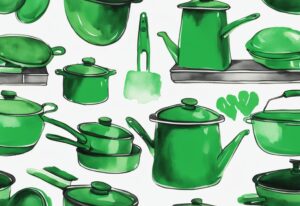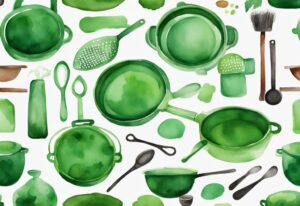Is Silicone Microwave Safe? Unveiling the Truth About Kitchenware Safety
Firstly, allow me to congratulate you. By clicking on this article, you’re actively taking steps towards maintaining a non-toxic kitchen. Now, to your burning question: “Is silicone microwave safe?” It’s not a simple yes or no, and I’m here to guide you through the complexities.
In this article, we’ll evaluate the safety of silicone in the microwave, focus on FDA regulations, its heat resistance prowess, and share tips on spotting microwave-friendly silicone items. But it doesn’t stop at understanding; practical tips on using these products safely will also be provided.
As we turn to silicone for everything from baking to storing our leftovers, understanding its safety parameters is crucial. So, let’s create a safer kitchen together, one item at a time. Let the digestible science and handy tips begin.
Understanding the Safety of Silicone in the Microwave
FDA Approval and Safety
Since 1979, the FDA has given its stamp of approval for the use of food-grade silicone in everyday use, including cooking. This endorsement stems from its safety and incredible versatility. Food-grade silicone is engineered to handle a variety of applications, such as baking in the oven, freezing, and of course, using in the microwave. What’s remarkable here is the non-toxic and stable nature of silicone, ensuring it remains safe even under various conditions. The FDA confirms that silicone cookware and utensils are free from harmful chemicals, thanks to its composition—polydimethylsiloxane (PDMS), a synthetic polymer, making it essential to understand what qualifies as FDA food-grade silicone for safe use in your kitchen. For more information on this, check out this detailed article on FDA food grade silicone. This translates into reliable performance without compromising on safety.
Heat Resistance and Durability
Silicone kitchenware stands out for its impressive heat resistance, withstanding temperatures up to 428 degrees Fahrenheit (220 degrees Celsius). Whether you’re baking, cooking, or microwaving, silicone can handle a wide array of culinary tasks. Besides high heat tolerance, it also exhibits amazing durability, withstanding both extreme cold and heat without showing signs of wear and tear. High-quality, food-grade silicone retains its shape and functionality even after extended microwave use. However, using it frequently at extreme temperatures can eventually impact its structural integrity. Yet, under normal usage, silicone remains resilient, resisting melting, deforming, or breaking down.
Non-Toxic and Non-Leaching Properties
One of the reassuring aspects of food-grade silicone is its non-toxic and non-leaching properties. Made from inert substances, it ensures that no chemicals seep into your food, no matter the temperature changes. This stability makes it ideal for different cooking environments, including microwaves. Its non-porous nature adds another layer of safety by preventing bacterial growth or absorbing odors.
This cleanliness and hygiene mean high-quality silicone kitchenware is a trusted choice for microwave use. The added benefit is the peace of mind that comes with knowing you’re preparing meals in a non-toxic way.
Detecting Microwave-Safe Silicone Products
It’s so important to ensure your silicone products are safe for microwaving. This involves understanding key markers like proper labeling and certification, knowing how to perform a twist test, and staying clear of silicone with fillers. Let’s dive into these aspects to help you make safe choices.
Labeling and Certification
When pondering the question, is silicone microwave safe?, verifying labeling and certification is crucial. Always check for clear labels that explicitly mention the product as microwave-safe. Certifications indicating the item is made from 100% food-grade silicone are your best bet. Not all silicone products meet these rigorous standards, making labels and certifications vital for your safety. By ensuring they are properly labeled, you eliminate health risks that come with microwaving non-certified silicone.

How to Conduct the Twist Test
One simple yet effective way to determine if your silicone product can safely withstand microwave heat is the twist test. This involves twisting a part of the silicone item; if the twisted area turns white, it likely contains fillers and is not 100% pure silicone. Fillers can make silicone unsafe for microwaving as they can cause unpredictable behavior like melting or the release of harmful substances under heat. This quick test can save you from potential hazards and ensure you’re using a product that’s entirely silicone.
Avoiding Silicone with Fillers
It’s essential to be vigilant in choosing silicone products, especially for microwaving. High-quality silicone should be free from fillers, as fillers can cause the silicone to melt, deform, or degrade in the microwave, making it unreliable. By opting for pure, food-grade silicone products, you ensure that your items will remain stable and hold their shape even when exposed to high microwave temperatures. This way, you preserve both the integrity of your silicone items and your safety.
Guidelines for Using Silicone in the Microwave
Microwaving with silicone can be a safe and convenient way to prepare meals when certain guidelines are followed. This section delves into best practices and common mistakes to help you use silicone in the microwave effectively.
Best Practices for Safe Microwave Use
When you’re using silicone in the microwave, it’s a good idea to place silicone containers on a microwave-safe plate. This little step provides extra stability and helps prevent any potential spills.
Remember to always follow the manufacturer’s instructions for use and care. It’s a small effort that pays off in the long run by ensuring the longevity and effectiveness of your silicone products.
Since silicone can get very hot when microwaved, always use a dishcloth or glove to handle it safely. It’s a simple safety measure that can prevent burns and mishaps in the kitchen. Additionally, if you’re wondering whether parchment paper can be microwaved, it’s worth looking into to avoid any kitchen mishaps.
Make it a habit to regularly inspect your silicone cookware for any signs of wear or damage. This includes checking for cracks, deformation, or discoloration. These signs can indicate that the product is no longer safe to use, and it might be time for a replacement.
Common Mistakes to Avoid
A critical mistake to avoid is using silicone bakeware with metal parts or trim in the microwave. Metal can spark and potentially cause a fire, posing significant dangers.

It’s also crucial to steer clear of low-quality silicone products. These might not be 100% food-grade and could contain unsafe fillers. These fillers can behave unpredictably and might release toxic substances when heated.
To ensure safe cooking, avoid overcooking by sticking closely to recommended cooking times and regularly checking your food. This not only helps maintain the quality of both the silicone product and the food but also ensures a safer cooking experience.
Concerns of Silicone Use in Microwaves
When pondering the question “is silicone microwave safe?”, it’s important to address several key aspects to ensure you’re making informed decisions for your health and culinary endeavors.
Potential Drawbacks in the Microwave
Using silicone kitchenware in the microwave can sometimes pose a few challenges. Though I appreciate silicone’s flexibility in fitting various shapes, this very trait can cause uneven cooking results. To avoid this, I always place silicone on a stable, solid base to help maintain consistency.
A significant concern is silicone’s poor heat conductivity. If you are curious about other kitchen materials, you might want to know, can you microwave parchment paper. Unlike metals or ceramics, silicone doesn’t distribute heat evenly. This can be particularly frustrating when trying to achieve a beautifully browned crust on baked goods. It’s something I’ve struggled with when aiming for that perfect crispy texture.
Additionally, I’ve noticed that silicone kitchenware can develop a stubborn greasy layer over time. This residue requires special attention to clean properly, ensuring the items retain their non-toxic and non-porous properties. If you’re curious about skincare as well, you might want to know, is Carmex good for your lips? It’s worth the effort to keep everything hygienic for microwave use.
Environmental Impact of Silicone
While thinking about “is silicone microwave safe?”, I can’t help but reflect on its environmental footprint too. Silicone, unlike many plastics, isn’t biodegradable. Its presence in landfills is a long-term issue since it doesn’t naturally break down.
Recycling silicone also presents challenges. Despite its long-lasting nature, the recycling options for silicone products remain limited. This means that when these items are discarded, they contribute to landfill waste. It’s a sobering consideration for anyone, like me, who is committed to reducing their environmental impact.

FAQ
Discovering the Safety of Silicone in the Microwave
Can silicone cookware be used safely in the microwave?
Absolutely, high-quality silicone cookware can be safely used in the microwave. It’s vital to check that the product is specifically labeled as microwave-safe. This precaution helps ensure that you’re using a reliable product, minimizing potential risks.
Does silicone release chemicals when microwaved?
No, food-grade silicone is designed to be safe and does not release chemicals when microwaved. It’s crafted from inert substances that maintain stability even at high temperatures. This means no harmful leaching into your food, giving you peace of mind.
How can I tell if my silicone product is microwave-safe?
To determine if silicone is microwave-safe, look for labels and certifications that confirm it’s 100% food-grade. Additionally, performing a twist test can be revealing. If the silicone changes color or shows fillers, it indicates lower quality, and you might want to rethink using it.
What precautions should I take when using silicone in the microwave?
Taking a few extra steps can ensure your safety. Always use a microwave-safe plate for added stability. Handle silicone cookware with care, using a dishcloth or gloves to protect your hands from the heat. Follow the manufacturer’s instructions and avoid silicone products that contain metal parts. Periodically inspecting your silicone for any damage or wear also helps maintain safety.
Conclusion
Silicone’s safety in the microwave is well-documented due to its inert, non-toxic nature and heat-resistant properties. As a synthetic polymer known as polydimethylsiloxane (PDMS), food-grade silicone has been trusted in culinary applications since its FDA approval in 1979. Its non-toxic characteristics and resistance to high temperatures make it a reliable option for microwave usage. When properly utilized, high-quality silicone does not release harmful chemicals, ensuring your food remains safe during heating.
However, ensuring that the silicone products you use are of the highest quality is paramount. Look for certifications that confirm the material is 100% food-grade silicone, and always check labels for microwave-safe indications. The twist test can be an effective method to detect unwanted fillers that might compromise the integrity of the silicone when subjected to microwave heat.
Despite its many advantages, silicone does present some challenges and considerations. Being flexible, it lacks the structural rigidity seen in materials like glass or metal, which may necessitate the use of a stable base when microwaving. Additionally, its poor heat conductivity means it doesn’t brown baked goods as effectively—although this is a minor trade-off for its overall benefits.
Silicone’s environmental aspects also deserve attention. Although durable and reusable, silicone is neither biodegradable nor easily recyclable, raising concerns about its long-term environmental footprint. Regularly inspecting for wear or damage and properly maintaining your silicone kitchenware can extend its lifespan, minimizing environmental impact.
To sum up, silicone proves to be a safe, convenient, and versatile option for microwave cooking, as long as you choose high-quality, food-grade silicone products. Balancing its advantages with mindful usage and proper care will ensure you can enjoy the benefits without compromising safety or environmental sustainability.
Hi, I’m Olivia Green, the voice behind nontoxicways.com. I’m passionate about helping you make the shift to a healthier, non-toxic lifestyle without feeling overwhelmed. I love sharing my personal journey, from small changes to big transformations, along with practical tips that make it all feel doable. My goal is to inspire and guide you toward a lifestyle that benefits both your well-being and the planet. Let’s take this journey together, one simple step at a time!














Post Comment